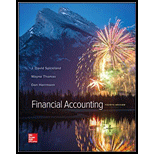
Concept explainers
1.
Calculate cash paid to suppliers.
1.
Explanation of Solution
Cash outflows: The amount of cash paid by a company for the operating, investing, and financing activities of the business during a certain period is referred to as
Calculate cash paid to suppliers.
| Situation | Cost of goods sold | Inventory Increase (Decrease) | Accounts payable Increase (Decrease) | Cash paid to suppliers |
| 1 | $150 | $25 | $20 | (1) $155 |
| 2 | $150 | ($25) | $20 | (2) $105 |
| 3 | $150 | $25 | ($20) | (3) $195 |
| 4 | $150 | ($25) | ($20) | (4) $145 |
Table (1)
Working note:
Calculate amount of cash paid to suppliers for each situation:
Situation 1:
Situation 2:
Situation 3:
Situation 4:
2.
Prepare the summary
2.
Explanation of Solution
Prepare the summary journal entry for each situation.
Situation 1:
| Date | Accounts title and explanation | Debit ($) | Credit ($) |
| Cost of goods sold | 150 | ||
| Inventory | 25 | ||
| Accounts payable | 20 | ||
| Cash | 155 | ||
| (To record the summary journal entry) |
Table (1)
- Cost of goods sold is an expense account and it decreases the
stockholders’ equity. Hence, debit cost of goods sold with $150. - Inventory is an asset account and it is increased. Hence, debit inventory with $25.
- Accounts payable is a liability account and it is increased. Hence, credit accounts payable with $20.
- Cash is an asset account and it is decreased. Therefore, credit cash with $155.
Situation 2:
| Date | Accounts title and explanation | Debit ($) | Credit ($) |
| Cost of goods sold | 150 | ||
| Inventory | 25 | ||
| Accounts payable | 20 | ||
| Cash | 105 | ||
| (To record the summary journal entry) |
Table (2)
- Cost of goods sold is an expense account and it decreases the stockholders’ equity. Hence, debit cost of goods sold with $150.
- Inventory is an asset account and it is decreased. Hence, credit inventory with $25.
- Accounts payable is a liability account and it is decreased. Hence, credit accounts payable with $20.
- Cash is an asset account and it is decreased. Therefore, credit cash with $105.
Situation 3:
| Date | Accounts title and explanation | Debit ($) | Credit ($) |
| Cost of goods sold | 150 | ||
| Accounts payable | 20 | ||
| Inventory | 25 | ||
| Cash | 195 | ||
| (To record the summary journal entry) |
Table (3)
- Cost of goods sold is an expense account and it decreases the stockholders’ equity. Hence, debit cost of goods sold with $150.
- Inventory is an asset account and it is increased. Hence, debit inventory with $25.
- Accounts payable is a liability account and it is decreased. Hence, debit accounts payable with $20.
- Cash is an asset account and it is decreased. Therefore, credit cash with $195.
Situation 4:
| Date | Accounts title and explanation | Debit ($) | Credit ($) |
| Cost of goods sold | 150 | ||
| Accounts payable | 20 | ||
| Inventory | 25 | ||
| Cash | 145 | ||
| (To record the summary journal entry) |
Table (4)
- Cost of goods sold is an expense account and it decreases the stockholders’ equity. Hence, debit cost of goods sold with $150.
- Accounts payable is a liability account and it is decreased. Hence, debit accounts payable with $20.
- Inventory is an asset account and it is decreased. Hence, credit inventory with $25.
- Cash is an asset account and it is decreased. Therefore, credit cash with $145.
Want to see more full solutions like this?
Chapter 11 Solutions
Financial Accounting (Connect NOT Included)
- Can you demonstrate the accurate method for solving this financial accounting question?arrow_forwardLast year, Baker's Delight, Inc., had an ROA of 8.5 percent, a profit margin of 12.4 percent, and sales of $25 million. Calculate Baker's Delight's total assets. (Enter your answer in millions.)arrow_forwardHow much is May's total cost of production?arrow_forward
- What amount of cost of goods sold?arrow_forwardCan you help me solve this general accounting problem with the correct methodology?arrow_forwardBramble Corp. started the year with total assets of $218,000 and total liabilities of $112,000. During the year, the business recorded $328,000 in revenues, $162,000 in expenses, and dividends of $52,000. What was stockholders' equity at the end of the year?arrow_forward

 AccountingAccountingISBN:9781337272094Author:WARREN, Carl S., Reeve, James M., Duchac, Jonathan E.Publisher:Cengage Learning,
AccountingAccountingISBN:9781337272094Author:WARREN, Carl S., Reeve, James M., Duchac, Jonathan E.Publisher:Cengage Learning, Accounting Information SystemsAccountingISBN:9781337619202Author:Hall, James A.Publisher:Cengage Learning,
Accounting Information SystemsAccountingISBN:9781337619202Author:Hall, James A.Publisher:Cengage Learning, Horngren's Cost Accounting: A Managerial Emphasis...AccountingISBN:9780134475585Author:Srikant M. Datar, Madhav V. RajanPublisher:PEARSON
Horngren's Cost Accounting: A Managerial Emphasis...AccountingISBN:9780134475585Author:Srikant M. Datar, Madhav V. RajanPublisher:PEARSON Intermediate AccountingAccountingISBN:9781259722660Author:J. David Spiceland, Mark W. Nelson, Wayne M ThomasPublisher:McGraw-Hill Education
Intermediate AccountingAccountingISBN:9781259722660Author:J. David Spiceland, Mark W. Nelson, Wayne M ThomasPublisher:McGraw-Hill Education Financial and Managerial AccountingAccountingISBN:9781259726705Author:John J Wild, Ken W. Shaw, Barbara Chiappetta Fundamental Accounting PrinciplesPublisher:McGraw-Hill Education
Financial and Managerial AccountingAccountingISBN:9781259726705Author:John J Wild, Ken W. Shaw, Barbara Chiappetta Fundamental Accounting PrinciplesPublisher:McGraw-Hill Education





